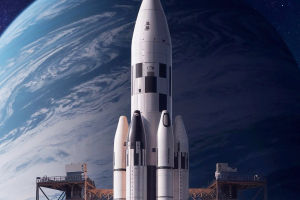Lykkers, have you ever wondered why China's first satellite, DongFangHong 1, continues to orbit the Earth for decades without running out of fuel? You might think it's a mystery, but actually, it's not so hard to understand if you think back to your high school physics lessons.
The simple truth is that satellites like DongFangHong 1 don't need fuel to stay in space. That's why it has been flying for 47 years and could continue to do so for much longer—possibly even drifting away from Earth.
Let's break it down into four easy parts to explain this amazing phenomenon.
1. How Does a Satellite Launch Into Space?
To start with, satellites are launched into space using rockets. Think of a rocket like a car and the satellite as a passenger. When a rocket launches, it's like the car taking a passenger to their destination. The rocket needs fuel to lift off, just like a car needs gasoline to drive. Once the rocket reaches the satellite's intended orbit, it releases the satellite, and the rocket will continue to burn fuel until it runs out and falls back to Earth. Meanwhile, the satellite, now in space, no longer needs fuel to keep moving.
2. What Keeps the Satellite Moving in Space?
Now, let's dive into the physics of it all. Every object in motion needs some kind of force to keep moving. This is known as inertia. On Earth, we have air resistance and gravity that slow things down, so we need to keep adding energy to overcome those forces. But once a satellite leaves Earth's atmosphere and enters space, there's no air resistance. This is key—because in the vacuum of space, there is no drag to slow the satellite down. So, when DongFangHong 1 separates from the rocket, it's already moving at high speed. The satellite's inertia, combined with the absence of air resistance, allows it to keep moving around the Earth without needing extra energy.
But there's another crucial force at play: gravity. The Earth's gravity keeps pulling the satellite towards it, which is why it stays in orbit. So, while the satellite doesn't need fuel, it relies on inertia to keep moving and gravity to keep it in orbit.
3. The Satellite's Function and Fuel Usage
It's important to distinguish between what keeps a satellite moving and what allows it to function. DongFangHong 1 was launched to perform several tasks, such as playing the song "DongFangHong" in space, testing satellite technologies, and studying the ionosphere and atmospheric density. To carry out these functions, the satellite needed to run its onboard equipment, and for that, it required fuel.
DongFangHong 1 was designed to last for 20 days, with a little extra fuel to extend its mission to 28 days. Once the fuel ran out, it couldn't perform these tasks anymore, but it still continued to orbit the Earth. So, while the satellite's mission may have ended, its journey through space didn't.
4. Will DongFangHong 1 Ever Return to Earth?
So, you might be wondering, will DongFangHong 1 eventually fall back to Earth? The answer is no—at least not anytime soon. A satellite's fate largely depends on its orbit, specifically its closest point to Earth. Satellites orbiting higher than 500 km are usually safe from Earth's gravity pulling them back. This means their orbits can last for a long time. DongFangHong 1 orbits at a minimum distance of 429 km, and its highest point is 2,036 km away.
However, space isn't empty. There are other planets and objects that also have gravitational pull. So, while DongFangHong 1 isn't likely to return to Earth anytime soon, it might slowly drift off course due to the gravitational influence of other celestial bodies. Over time, it could move farther away from Earth. As of 2009, its orbit had slightly changed, and by 2019, it was already moving farther away from Earth.
DongFangHong 1 holds a special place in China's history as the first man-made satellite launched into space. While many of us might hope to see it return to Earth one day, that might not happen. Instead, it will continue to carry our dreams as it drifts through the vastness of space, forever orbiting the Earth. The satellite's legacy remains as a symbol of China's space achievements, and we can proudly say that, even without fuel, it's been soaring through space for more than four decades—truly an incredible feat!


